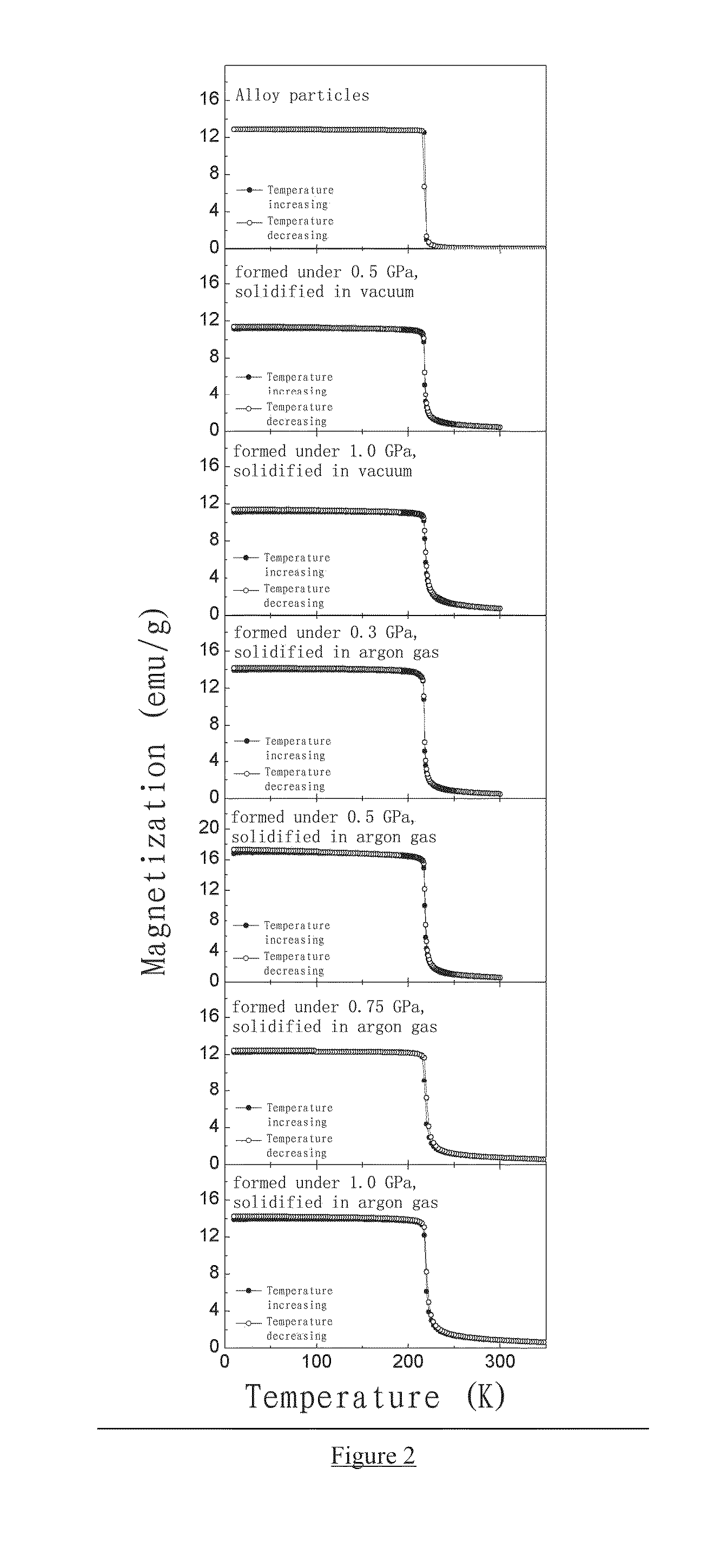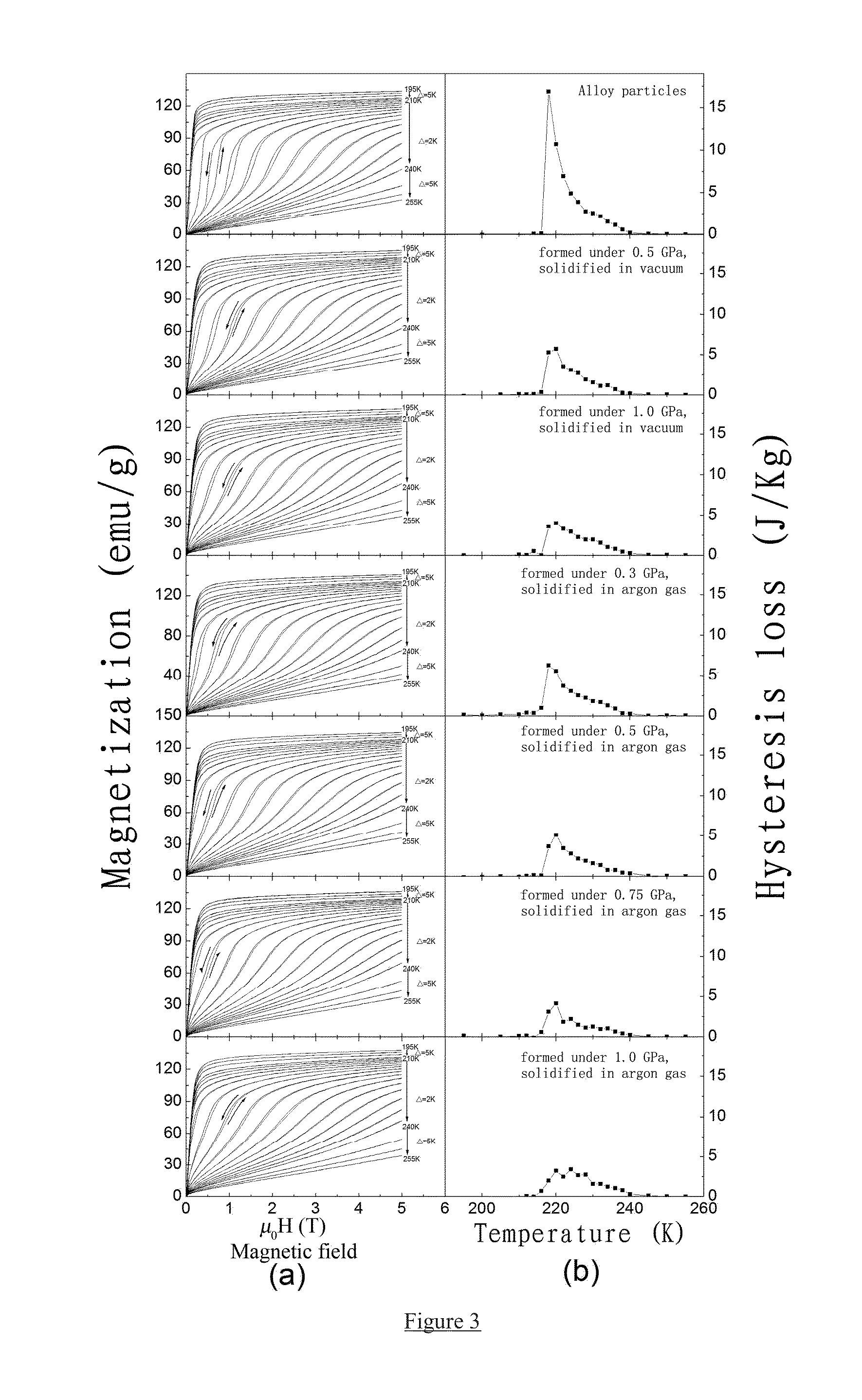BONDED La(Fe,Si)13-BASED MAGNETOCALORIC MATERIAL AND PREPARATION AND USE THEREOF
a magnetocaloric material and bonded technology, applied in the field of high-strength, bonded la (fe, si) 13-based magnetocaloric material, can solve the problems of gd—si—ge, not only expensive, but also requires further purification of raw materials, and the raw materials used to prepare mn—fe, etc., to achieve low price, easy operation and industrialization, and cost-effective
- Summary
- Abstract
- Description
- Claims
- Application Information
AI Technical Summary
Benefits of technology
Problems solved by technology
Method used
Image
Examples
example 1
Preparation of High-Strength Magnetocaloric Material LaFe11.6Si1.4C0.2
[0126]1) The materials were prepared in accordance with the chemical formula LaFe11.6Si1.4C0.2. The raw materials included La, Ce, Fe, Si and FeC. FeC alloy was used to provide C (carbon). The amount of the elementary Fe added thereto was reduced properly since the FeC alloy also contains Fe element, so that the proportion of each element added still met the requirement for the atomic ratio in the chemical formula of the magnetic material.
[0127]2) The raw materials formulated in step 1), after mixed, was loaded into an arc furnace. The arc furnace was vacuumized to a pressure of 2×10−3 Pa, purged with high-purity argon with a purity of 99.996 wt % twice, and then filled with high-purity argon with a purity of 99.996 wt % to a pressure of 1 atm. The arc was struck (the raw materials were smelted together to form alloy after striking) to generate alloy ingots. Each alloy ingot was smelted at a temperature of 2000° ...
example 2
Preparation of High-Strength Magnetocaloric Material La0.7Ce0.3Fe11.6Si1.4C0.2
[0139]1) The materials were prepared in accordance with the chemical formula La0.7Ce0.3Fe11.6Si1.4C0.2. The raw materials included industrial-pure LaCe alloy, Fe, Si, La and FeC, wherein elementary La was added to make up the La insufficience in the LaCe alloy and FeC alloy was used to provide C (carbon). The amount of the elementary Fe added thereto was reduced properly since the FeC alloy also contains Fe element, so that the proportion of each element added still met the requirement for the atomic ratio in the chemical formula of the magnetic material.
[0140]2) The raw materials prepared in step 1), after mixed, was loaded into an arc furnace. The arc furnace was vacuumized to a pressure of 2×10−3 Pa, purged with high-purity argon with a purity of 99.996 wt % twice, and then filled with high-purity argon with a purity of 99.996 wt % to a pressure of 1 atm. The arc was struck (the raw materials were smel...
example 3
Preparation of High-Strength Magnetocaloric Material La0.7(Ce,Pr,Nd)0.3(Fe0.9Co0.1)11.9Si1.1
[0152]1) The materials were prepared in accordance with the chemical formula La0.7(Ce,Pr,Nd)0.3(Fe0.9Co0.1)11.9Si1.1. The raw materials included industrial-pure mischmetal La—Ce—Pr—Nd (with a purity of 99.6 wt %), elementary Fe, elementary Co, elementary Si elementary La and FeC alloy, wherein elementary La was added to make up the La insufficience in the mischmetal and FeC alloy was used to provide C (carbon). The amount of the elementary Fe added thereto was reduced properly since the FeC alloy also contains Fe element, so that the proportion of each element added still met the requirement for the atomic ratio in the chemical formula of the magnetic material.
[0153]2) The raw materials prepared in step 1), after mixed, was loaded into an arc furnace. The arc furnace was vacuumized to a pressure of 2×10−3 Pa, purged with high-purity argon with a purity of 99.996 wt % twice, and then filled w...
PUM
| Property | Measurement | Unit |
|---|---|---|
| particle size | aaaaa | aaaaa |
| particle size | aaaaa | aaaaa |
| particle size | aaaaa | aaaaa |
Abstract
Description
Claims
Application Information
 Login to View More
Login to View More - R&D
- Intellectual Property
- Life Sciences
- Materials
- Tech Scout
- Unparalleled Data Quality
- Higher Quality Content
- 60% Fewer Hallucinations
Browse by: Latest US Patents, China's latest patents, Technical Efficacy Thesaurus, Application Domain, Technology Topic, Popular Technical Reports.
© 2025 PatSnap. All rights reserved.Legal|Privacy policy|Modern Slavery Act Transparency Statement|Sitemap|About US| Contact US: help@patsnap.com



